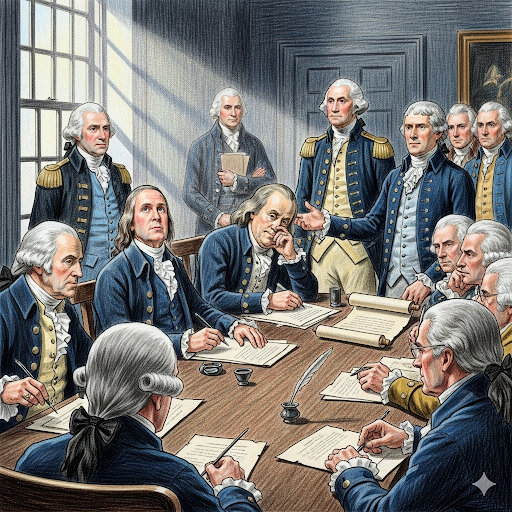Background and Causes
The American Declaration of Independence in 1776 emerged from decades of escalating political and economic tensions between Great Britain and its thirteen North American colonies. After the French and Indian War Britain attempted to consolidate control and recoup war expenses through new taxes and tighter regulation of colonial trade, measures that many colonists viewed as violations of their rights as Englishmen because those taxes were imposed without colonial representation in Parliament. Incidents such as the Stamp Act, the Townshend Acts, the Boston Massacre, and the Boston Tea Party heightened popular resistance and led the colonies to organize coordinated responses through committees and assemblies that challenged imperial authority.
Continental Congress and the Move toward Independence
Faced with increasingly punitive measures from Parliament and the presence of British troops in colonial towns, colonial leaders convened the Continental Congress to coordinate opposition and, after armed clashes at Lexington and Concord and the start of hostilities in 1775, to manage a military effort. The Second Continental Congress gradually shifted from seeking redress of grievances to asserting sovereign authority, culminating in the adoption of the Lee Resolution on July 2, 1776 and the formal adoption of the Declaration of Independence on July 4, 1776. The Declaration, drafted primarily by Thomas Jefferson, articulated Enlightenment ideals—natural rights, government by consent, and the right of revolution—and provided an international and moral rationale for political separation.
Military Struggle and Internationalization
Proclaiming independence did not end conflict; it transformed a growing rebellion into a war for nationhood. The Revolutionary War unfolded unevenly across a vast geographic theater, from New England to the southern colonies, and relied on irregular militia, a Continental Army under George Washington, and complex supply and recruitment challenges. Crucial military and diplomatic developments shifted the balance: American resilience on the battlefield and strategic victories such as Saratoga helped persuade France to recognize and ally with the new United States, turning the conflict into a broader international war that brought vital military and financial support, while later Spanish and Dutch involvement further constrained British options.
Human and Economic Costs
The war exacted severe human and economic costs. Casualties included battle deaths, disease, and civilian suffering caused by occupation, raids, and internecine violence that marked the conflict as in part a civil war. The Continental Congress and state governments faced fiscal strain as they struggled to fund armies, supply troops, and stabilize wartime economies; inflation, requisitions, and disrupted trade imposed hardship on civilians and soldiers alike. Loyalist-Patriot divisions produced social fracture and, in many locales, property confiscations and forced migrations that reshaped local demography and politics. Despite hardships, the wartime experience forged political cohesion among disparate colonies and created institutions that would later influence the framing of national governance.
Political Outcomes and Constitutional Beginnings
Independence produced immediate and long-term political transformations. The thirteen former colonies set about forming governments under state constitutions and experimented with republican institutions, while the Continental Congress drafted the Articles of Confederation as an initial national framework. Military victory and diplomatic recognition culminated in the Treaty of Paris (1783), which formally ended hostilities and secured British recognition of American independence and territorial gains. The revolutionary experience exposed weaknesses in the confederation system and prompted debates about sovereignty, representation, and federal authority that ultimately led to the Constitutional Convention and the creation of a stronger federal republic in the 1780s.
Global Significance and Legacy
The Declaration and the Revolution had significance far beyond the immediate founding of the United States. The assertions of natural rights and popular sovereignty resonated across the Atlantic world and helped catalyze later movements for reform and independence in Europe and the Americas, contributing to what historians call the Age of Revolution. Domestically, the Revolution set in motion social and political changes whose promises were unevenly realized; slavery persisted, women and many others remained excluded from full political rights, and the new nation wrestled with how revolutionary ideals would be applied in practice. Nonetheless, the birth of the United States as a republic introduced a novel model of government premised on consent and constitutional limits that profoundly influenced subsequent political thought and international developments.
